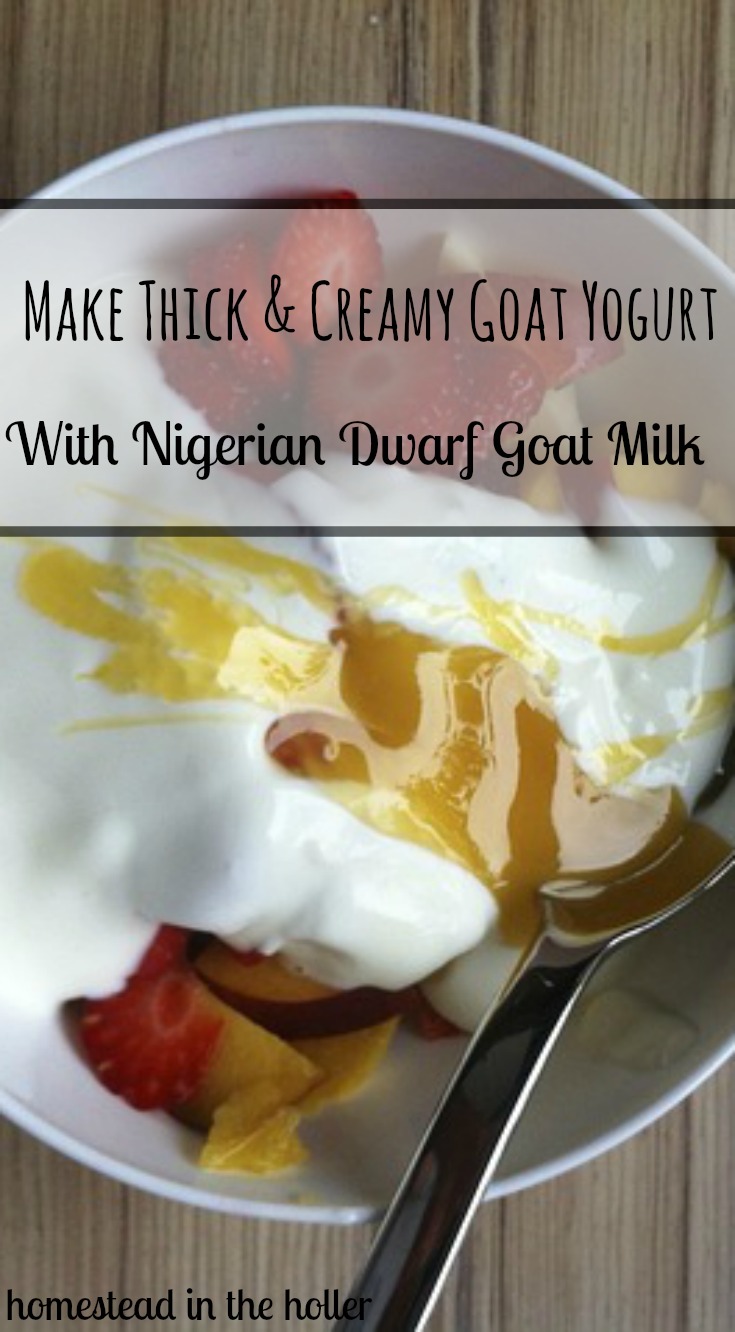Homestead in the Holler is a participant in the Amazon Services LLC Associates Program, an affiliate advertising program designed to provide a means for sites to earn advertising fees by advertising and linking to amazon.com.
My family loves yogurt. When our goat’s are in milk, I make 1 gallon of yogurt a week and I still can’t keep up with my kid’s appetites! Who can resist a bowl of thick, creamy goat’s milk yogurt with a bit of fruit mixed in?
Wait, thick and creamy goat’s milk yogurt?
All goat yogurt is tasty, but usually when you think of goat yogurt, you think of a thin yogurt. I have heard of different ways to thicken goat’s milk yogurt, which may work well. I haven’t had to try them. If you start off with Nigerian Dwarf goat’s milk there is no need to worry about thickening your yogurt. It will be thick and creamy on it’s own!
The breed of goat matters.
Different breeds of goats have a different percentage of milk fat in their milk. Most goat breeds have 2-6% milk fat, but Nigerian Dwarf goats have 6-10% milk fat. That’s what makes Nigerian Dwarf goat’s milk taste so sweet and good, which is one of the reasons why we love Nigerian Dwarf goats so much! This higher percentage of milk fat also means thicker yogurt. I have made yogurt from our other goats and it was delicious, but a thinner yogurt. We like the thick, creamy yogurt from Nigerian Dwarf goat’s milk so much, that we save it exclusively for yogurt making! If you have Nigerian Dwarf goat’s milk, you are off to a great start for some excellent yogurt!
Yogurt cultures will also affect the taste of the yogurt that you make. When buying yogurt cultures, you can choose from tart to mild tasting yogurt. Pick what appeals to you and your taste buds. We like a sweet, mild yogurt, so we use this culture from www.getcultures.com.
Let’s get started!
How to Make Goat’s Milk Yogurt
All goat’s milk or cow’s milk will work in this recipe. The method of making yogurt is the same.
Be sure to start with a clean pot and utensils. You may sterilize your pot and utensils beforehand by boiling some water in the pot, with your utensils inside and let boil for a few minutes. This will ensure that you aren’t introducing bad bacteria into your yogurt.
What you will need:
1/2 gallon of milk
Yogurt culture or 2-3 Tbsp. of organic plain yogurt
Thermometer
Quart jars for incubation
Oven and oven light for incubating yogurt (or method of choice)
Instructions:
Pour the milk into your pot and place it over medium heat. Stir frequently until the temperature of the milk reaches 180 degrees farenheit.
Turn off burner and place the pot of milk into a sink of cold water. Let it sit in the cold water until the temperature of the milk lowers to 110 degrees farenheit. Be sure to stir the milk occasionally to prevent a “skin” layer to form over the top of the milk. If that happens, don’t despair! It is easily skimmed off of the top and won’t affect your yogurt in any way.
Once the milk has lowered to 110 degrees, take the pot of milk out of the cold water. Add in your yogurt culture of choice to the milk and gently stir to incorporate.
Pour milk into 2 quart jars and place into cold oven with the oven light turned on. You can use a yogurt incubator, dehydrator, or crockpot to incubate your yogurt. However, I have found the oven with the oven light on will incubate the yogurt at 110 degrees farenheit, which is exactly what is needed. I have nothing against gadgets, but with a small kitchen that has very little storage, this method works extremely well for me.
Incubate the yogurt for 6-12 hours. The longer you incubate, the more tart your yogurt will be. We prefer to incubate our yogurt for 6 hours.
Once the yogurt has incubated, place the jars of yogurt in the fridge to chill. The yogurt will thicken up some more as it cools in the fridge.
Enjoy! Our favorite way to eat yogurt is with some fresh fruit, sweetened with honey or maple syrup. MMMmmm So good.

Hi! Around here I wear many hats. Homesteader, farmer, homemaker, homeschool mom, gardener and builder. We strive for a simple, self-sufficient life on our little piece of paradise. Read more





Pingback: How to Make Butter Using a Food Processor | Rootsy Network
Pingback: Essential Equipment for Making Hard Cheese - Old Paths To New Homesteading And Self-Reliant Living
Pingback: Getting Started Making Hard Cheese - Homestead In The Holler
Pingback: Milk Kefir - Homestead In The Holler